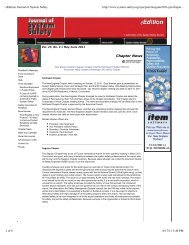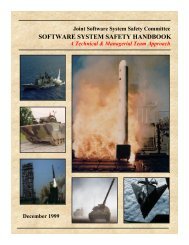Air Force System Safety Handbook - System Safety Society
Air Force System Safety Handbook - System Safety Society
Air Force System Safety Handbook - System Safety Society
You also want an ePaper? Increase the reach of your titles
YUMPU automatically turns print PDFs into web optimized ePapers that Google loves.
After using the checklist, there are some hints that may be<br />
helpful in selecting Tasks. For the customer, it is often better<br />
to time safety analyses deliverables based upon significant<br />
program milestones (like a preliminary design review) than to<br />
specify a certain number of days after contract award. This<br />
allows greater flexibility in case the design schedule changes.<br />
Whenever practical, consider requesting an update to an<br />
existing report instead of a whole new report. This can be a<br />
cost saver. If uncertainties exist in design which make a<br />
difference in what analysis is requested (ex. unsure if flight<br />
controls will be fly-by-wire or mechanical), leave the option to<br />
decide after the program has progressed. An example would<br />
be to add to the statement of work to perform fault tree<br />
analysis on a set number of topics mutually agreed upon at<br />
the system safety working group. Contractors should be<br />
particularly careful with contracts that require many analyses<br />
but few deliverables. It is especially important to keep an<br />
orderly backup file of all information that was used to support<br />
the deliverables. This file should be made available to the<br />
customer for review. This checklist can form part of a<br />
substantiation for additional budget or could surface areas for<br />
renegotiating or trading of tasks. Both customer and contractor<br />
can go beyond just identifying the particular MIL-STD-882<br />
tasks.<br />
4.7 Abuses. (16:C-1 to C-2)<br />
Various abuses to the process are noteworthy, such as boilerplate,<br />
smorgasbord, invisible, and cutup tailoring.<br />
The boilerplate utilizes verbiage that has been used numerous<br />
times before. It references the original MIL-STD-882, not the<br />
current version. Defenders of this method claim it is “proven<br />
effective” and has “management approval.” New start<br />
programs should use the latest version. It may be valuable as<br />
a method of time savings to utilize similar requirements from<br />
previous similar programs; however, it is often used for all<br />
programs regardless of similarities.<br />
The smorgasbord contains practically everything in MIL-STD--<br />
882. Many times, there is a long list of tasks with only a few<br />
deliverables. The theory behind this is if a little bit of 882 is<br />
good to have, a lot must be better. This burdens the contractor<br />
to programs; however, it is often used for all programs regardless<br />
of similarities.<br />
The smorgasbord contains practically everything in MIL-STD--<br />
882. Many times, there is a long list of tasks with only a few<br />
deliverables. The theory behind this is if a little bit of 882 is<br />
good to have, a lot must be better. This burdens the<br />
contractor to produce a lot of programs; however, it is often<br />
used for all programs regardless of similarities.<br />
The smorgasbord contains practically everything in MIL-STD--<br />
882. Many times, there is a long list of tasks with only a few<br />
deliverables. The theory behind this is if a little bit of 882 is<br />
good to have, a lot must be better. This burdens the contractor<br />
to This method suggests the customer views safety as a<br />
spectator sport. Customer involvement is essential to<br />
success. The application of MIL-STD-882D as a whole<br />
document should prevent this from occurring.<br />
Invisible tailoring of tasks is accomplished by omitting the very<br />
last paragraph of each task. This paragraph describes what<br />
the managing authority shall do. This is of no concern to the<br />
contractor. So, it is as if this task were never tailored. This<br />
misses the whole point of tailoring.<br />
Cutup contracts are ones which bear little resemblance to the<br />
original input by the customer’s safety department because it<br />
37<br />
was “revised” before final transmittal to the contractor. Unfortunately,<br />
the contractor will have to work with the customer’s<br />
safety department and try to satisfy their original needs without<br />
exceeding the bounds of the actual content.<br />
4.8 Small Programs. (33:123-132)<br />
A major program may need most or all of the tasks in<br />
Deskbook applied to the program. Small programs are much<br />
different. There is a need for the further delineation of a set of<br />
recommended procedures for conducting a small system<br />
safety program. Such a program may be called for in such<br />
cases as small projects (e.g., the design and fabrication of a<br />
missile transport cart), projects with obviously minimal hazards<br />
(e.g., development of a new mechanical typewriter), projects<br />
that do not fit into the normal life cycle process (e.g., military<br />
facilities design and construction) and, unfortunately, projects<br />
for which the safety activity is dollar limited.<br />
The following are recommended as a minimum effort in a system<br />
safety program:<br />
1. Prepare a preliminary hazards list (PHL).<br />
2. Conduct a preliminary hazard analysis (PHA).<br />
3. Assign a Risk Assessment Value for each item.<br />
4. Assign a priority for taking the recommended action<br />
to eliminate or control the hazards, according to the<br />
Risk Assessment Values.<br />
5. Evaluate the possibility of deleterious effects from<br />
interfaces between the recommended actions and<br />
other portions of the system.<br />
6. Take the recommended actions to modify the<br />
system.<br />
7. Prepare a <strong>System</strong> <strong>Safety</strong> Assessment Report as a<br />
wrap-up of the system safety program.<br />
The PHL can be derived in several ways. One of these is by<br />
the examination of the energy transfer in the system. This is<br />
based on the concept that all losses are created by an interference<br />
with the normal exchange of energy. The system is<br />
examined for incorrect, untimely, or omitted energy exchanges<br />
as a base for the PHL. There are also available hazard review<br />
checklists in which hazards are listed, together with the usual<br />
occurrence mode, the possible cause and the possible effects.<br />
The PHA is the initial development of the relationships<br />
between hazard causes (faults), effects, and recommended<br />
actions to be taken to eliminate or control the hazards.<br />
An in-depth hazard analysis generally follows the PHA with a<br />
subsystem hazard analysis, a system hazard analysis, and an<br />
operating and support hazard analysis, as appropriate, but for<br />
a small safety program, the PHA will usually suffice as the only<br />
formal analysis.<br />
A comprehensive evaluation is needed of the safety risks<br />
being assumed prior to test or evaluation of the system or at<br />
contract completion. It identifies all safety features of the<br />
hardware and system design and procedural hazards that may<br />
be present in the system being acquired and specific procedural<br />
controls and precautions that should be followed.<br />
It is to be remembered that the hazards encountered in a<br />
small program can be as severe and as likely to occur as<br />
those of a major program. Usually one can expect fewer<br />
hazards in a small program. Caution needs to be exerted to<br />
ensure that in tailoring the system safety effort to fit a small<br />
program, one does not perform a wholesale slashing, but




